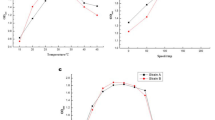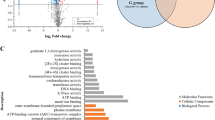Abstract
A novel salt-tolerant strain DUT_AHX, which was capable of utilizing nitrobenzene (NB) as the sole carbon source, was isolated from NB-contaminated soil. Furthermore, it was identified as Streptomyces albidoflavus on the basis of physiological and biochemical tests and 16S ribosomal DNA (rDNA) sequence analysis. It can grow in the presence of NaCl up to 12% (w/v) or NB up to 900 mg/l in mineral salts basal (MSB) medium. The exogenously added osmoprotectants such as glycin, glutamic acid, proline, betaine and ectoine can improve growth of strain DUT_AHX in the presence of 10% (w/v) NaCl. NB-grown cells of strain DUT_AHX in modified MSB medium can degrade NB with the concomitant release of ammonia. Moreover, crude extracts of NB-grown strain DUT_AHX mainly contained 2-aminophenol 1,6-dioxygenase activity. These indicate that NB degradation by strain DUT_AHX might involve a partial reductive pathway. The proteins induced by salinity stress or NB were analyzed by native-gradient polyacrylamide gel electrophoresis (PAGE) and sodium dodecyl sulfate (SDS)-PAGE. In NB-induced proteins de novo, 141 kDa protein on the native-gradient PAGE gel was excised and electroeluted. Furthermore, enzyme tests exhibit the 2-aminophenol 1,6-dioxygenase activity of purified 141 kDa protein is 11-fold that of the cell-free extracts. The exploitation of strain DUT_AHX in salinity stress will be a remarkable improvement in NB bioremediation and wastewater treatment in high salinity.












Similar content being viewed by others
References
Apte SK, Bhagwat AA (1989) Salinity-stress-induced proteins in two nitrogen-fixing Anabaena strains differentially tolerant to salt. J Bacteriol 171:909–915
Bradford MM (1976) A rapid and sensitive method for the quantitation of microgram quantities of protein utilizing the principle of protein-dye binding. Anal Biochem 72:248–254. doi:10.1016/0003-2697(76)90527-3
Buchanan RE, Gibbons NE (1984) Bergey’s manual of systematic bacteriology. Williams and Wilkins Co., Baltimore
De Baere LA, Devocht M, Assche PV, Verstraete W (1984) Influence of high NaCl and NH4Cl salt levels on methanogenic associations. Water Res 18:543–648. doi:10.1016/0043-1354(84)90201-X
Duché O, Trémoulet F, Glaser P, Labadie J (2002) Salt stress proteins induced in Listeria monocytogenes. Appl Environ Microbiol 68:1491–1498. doi:10.1128/AEM.68.4.1491-1498.2002
Gerhardt P, Murray RG, Wood WA, Krieg NR (1994) Methods for general and molecular bacteriology. American Society for Microbiology, Washington, DC
He Z, Davis JK, Spain JC (1998) Purification, characterization, and sequence analysis of 2-aminomuconic 6-semialdehyde dehydrogenase from Pseudomonas pseudoalcaligenes JS45. J Bacteriol 180:4591–4595
He Z, Nadeau LJ, Spain JC (2000) Characterization of hydroxylaminobenzene mutase from pNBZ139 cloned from Pseudomonas pseudoalcaligenes JS45. A highly associated SDS-stable enzyme catalyzing an intramolecular transfer of hydroxyl groups. Eur J Biochem 267:1110–1116
He Z, Spain JC (1998) A novel 2-aminomuconate deaminase in the nitrobenzene degradation pathway of Pseudomonas pseudoalcaligenes JS45. J Bacteriol 180:2502–2506
Iyer V, Fernandes T, Apte SK (1994) A role for osmotic stress-induced proteins in the osmotolerance of a nitrogen-fixing cyanobacterium, Anabaena sp. strain L-31. J Bacteriol 176:5868–5870
Keith LH, Telliard WA (1979) Priority pollutants: I. A perspective view. Environ Sci Technol 13:416–423. doi:10.1021/es60152a601
Kumar S, Tamura K, Nei M (2004) MEGA3: integrated software for molecular evolutionary genetics analysis and sequence alignment. Brief Bioinform 5:150–163. doi:10.1093/bib/5.2.150
Lane DJ (1991) 16S/23S rRNA sequencing. In: Stackebrandt E, Goodfellow M (eds) Nucleic acid techniques in bacterial systematics. John Wiley and Sons, New York, pp 115–148
Lendenmann U, Spain JC (1996) 2-aminophenol 1, 6-dioxygenase: a novel aromatic ring cleavage enzyme purified from Pseudomonas pseudoalcaligenes JS45. J Bacteriol 178:6227–6232
Li HY, Huang Y, An LC (2006) Study of treatment technology of wastewater containing nitrobenzene compounds. Ind Water Treat 26:40–43
Li Y, Hu HY, Wu QY (2007) Isolation and characterization of psychrotrophic nitrobenzene-degrading strains from river sediments. Bull Environ Contam Toxicol 79:340–344. doi:10.1007/s00128-007-9239-y
Liu L, Wu JF, Ma YF, Wang SY, Zhao GP, Liu SJ (2007) A novel deaminase involved in chloronitrobenzene and nitrobenzene degradation with Comamonas sp. strain CNB-1. J Bacteriol 189:2677–2682. doi:10.1128/JB.01762-06
Marmur J, Doty P (1962) Determination of the base composition of deoxyribonucleic acid from thermal denaturation temperature. J Mol Biol 5:109–118
Mojica FJM, Cisneros E, Ferrer C, Rodríguez-Valera F, Juez G (1997) Osmotically induced response in representatives of halophilic prokaryotes: the bacterium Halomonas elongate and the archaeon Haloferax volcanii. J Bacteriol 179:5471–5481
Nishino SF, Spain JC (1993) Degradation of nitrobenzene by a Pseudomonas pseudoalcaligenes. Appl Environ Microbiol 59:2520–2525
Nishino SF, Spain JC (1995) Oxidative pathway for the biodegradation of nitrobenzene by Comamonas sp. strain JS765. Appl Environ Microbiol 61:2308–2313
Oh YS, Lee YH, Lee JH, Choi SC (2003) Characteristics of nitrobenzene degradation by Mycobacterium chelonae strain NB01. J Microbiol Biotechnol 13:309–312. doi:10.1159/000074546
Park HS, Kim HS (2000) Identification and characterization of the nitrobenzene catabolic plasmids pNB1 and pNB2 in Pseudomonas putida HS12. J Bacteriol 182:573–580. doi:10.1128/JB.182.3.573-580.2000
Park HS, Kim HS (2001) Genetic and structural organization of the aminophenol catabolic operon and its implication for evolutionary process. J Bacteriol 183:5074–5081. doi:10.1128/JB.183.17.5074-5081.2001
Park HS, Lim SJ, Chang YK, Livingston AG, Kim HS (1999) Degradation of chloronitrobenzenes by a coculture of Pseudomonas putida and Rhodococcus sp. Appl Environ Microbiol 65:1083–1091
Patil SS, Shinde VM (1989) Gas chromatographic studies on the biodegradation of nitrobenzene and 2, 4-dinitrophenol in the nitrobenzene plant wastewater. Environ Pollut 57:235–250. doi:10.1016/0269-7491(89)90015-8
Sambrook J, Russell DW (2001) Molecular cloning: a laboratory manual, 3rd edn. Cold Spring Harbor Laboratory Press, New York
Schraa G, Boone ML, Jetten MSM, van Neerven ARW, Colberg PJ, Zehnder AJB (1986) Degradation of 1, 4-dichlorobenzene by Alcaligenes sp. strain A175. Appl Environ Microbiol 52:1374–1381
Somerville CC, Nishino SF, Spain JC (1995) Purification and characterization of nitrobenzene nitroreductase from Pseudomonas pseudoalcaligenes JS45. J Bacteriol 177:3837–3842
Spain JC (1995) Biodegradation of nitroaromatic compounds. Annu Rev Toxicol 49:523–555
Storck WJ, Layman PL, Reisch MS, Thayer AM, Kirschner EM, Peaff G et al (1996) Facts and figures for the chemical industry. Chem Eng News 24:38–79
Takenaka S, Murakami S, Shinke R, Hatakeyama K, Yukawa H, Aoki K (1997) Novel genes encoding 2-aminophenol 1, 6-dioxygenase from Pseudomonas species AP-3 growing on 2-aminophenol and catalytic properties of the purified enzyme. J Biol Chem 272:14727–14732. doi:10.1074/jbc.272.23.14727
Thompson JD, Gibson TJ, Plewniak F, Jeanmougin F, Higgins DG (1997) The ClustalX windows interface: flexible strategies for multiple sequence alignment aided by quality analysis tools. Nucleic Acids Res 25:4876–4882. doi:10.1093/nar/25.24.4876
Vreeland RH (1987) Mechanisms of halotolerance in microorganisms. Crit Rev Microbiol 14:311–356
Weldingh K, Hansen A, Jacobsen S, Andersen P (2000) High resolution electroelution of polyacrylamide gels for the purification of single proteins from Mycobacterium tuberculosis culture filtrate. Scand J Immunol 51:79–86. doi:10.1046/j.1365-3083.2000.00655.x
Wu JF, Sun CW, Jiang CY, Liu ZP, Liu SJ (2005) A novel 2-aminophenol 1, 6-dioxygenase involved in the degradation of p-chloronitrobenzene by Comamonas strain CNB-1: purification, properties, genetic cloning and expression in Escherichia coli. Arch Microbiol 183:1–8. doi:10.1007/s00203-004-0738-5
Wu JF, Jiang CY, Wang BJ, Ma YF, Liu ZP, Liu SJ (2006) Novel partial reductive pathway for 4-chloronitrobenzene and nitrobenzene degradation in Comamonas sp. strain CNB-1. Appl Environ Microbiol 72:1759–1765. doi:10.1128/AEM.72.3.1759-1765.2006
Xiao Y, Wu JF, Liu H, Wang SJ, Liu SJ, Zhou NY (2006) Characterization of genes involved in the initial reactions of 4-chloronitrobenzene degradation in Pseudomonas putida ZWL73. Appl Microbiol Biotechnol 73:166–171. doi:10.1007/s00253-006-0441-3
Yao F, Xu TY, Lu YW (2003) Treatment of dyestuff wastewater containing nitrobenzene and its derivants. J Zhejiang Univer Technol 31:695–699
Zhao JS, Ward OP (1999) Microbial degradation of nitrobenzene and mono-nitrophenol by bacteria enriched from municipal activated sludge. Can J Microbiol 45:427–432. doi:10.1139/cjm-45-5-427
Zhen D, Liu H, Wang SJ, Zhang JJ, Zhao F, Zhou NY (2006) Plasmid-mediated degradation of 4-chloronitrobenzene by newly isolated Pseudomonas putida strain ZWL73. Appl Microbiol Biotechnol 72:797–803. doi:10.1007/s00253-006-0345-2
Author information
Authors and Affiliations
Corresponding author
Rights and permissions
About this article
Cite this article
Ai, H., Zhou, J., Lu, H. et al. Responses of a novel salt-tolerant Streptomyces albidoflavus DUT_AHX capable of degrading nitrobenzene to salinity stress. Biodegradation 20, 67–77 (2009). https://doi.org/10.1007/s10532-008-9200-8
Received:
Accepted:
Published:
Issue Date:
DOI: https://doi.org/10.1007/s10532-008-9200-8




